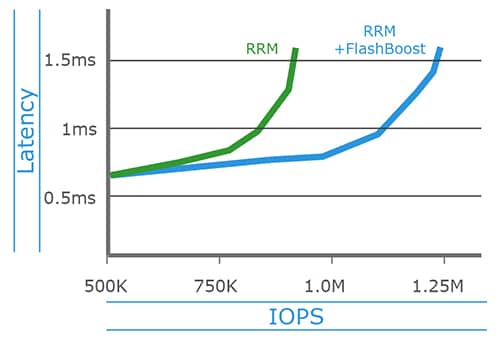EMC has announced VMAX FlashBoost software which allows VMAX arrays with SSD to operate more efficiently, driving performance gains by up to 75%. EMC is also offering their customers larger SSDs and making flash easier to buy by offering pre-configured bundles and discounts for both new and existing customers.
The traditional VMAX architecture works by accepting inbound read requests for data, the system then finds that data on the drives in the VMAX and finally pushes that data to a DRAM cache where it's presented back to the requesting host over Fibre Channel. Repeated requests for the same data are subsequently faster than the first with the DRAM cache (up to 2TB in the VMAX 40K) already holding that hot data request. EMC is adjusting how this workflow occurs thanks in large part to lessons learned from XtremSF, their server side flash cache solution, and their high penetration of VMAX arrays with SSDs inside.
With XtremSF a server has PCIe flash storage on board which is used as a front-end cache for EMC storage solutions like VNX and VMAX. For environments with XtremSF caching deployed, VMAX would ignore its typical process of moving data to the local DRAM cache when it knew the data already resided in the XtremSF server cache. This makes sense as the data on the host cache is closer and will provide a lower latency than the hop required to get to the VMAX, which is the entire point of server-side caching. The VMAX also does a little less work as there's one less data transaction to complete.

Now with VMAX FlashBoost, hybrid VMAX arrays (HDD/SSD) will operate in much the same way. When a data call comes in for data that resides on SSD, the VMAX will serve the request off of the SSD the first time, rather than moving the data to the DRAM cache first. VMAX will next move the data to the DRAM cache so in the event the same read request comes in again, the second hit will likely come from DRAM, providing even better latency than the first from SSD only. FlashBoost essentially saves overhead from the first read request because it doesn't have to migrate data to the cache immediately.
The vast majority of VMAX deployments include flash, roughly 70% according to EMC. While a large portion of those users leverage flash as a cache to accelerate most of their IO, many customers will use flash to create a flash-only pool for applications that are the most latency sensitive. The addition of FlashBoost is an immediate benefit to both use cases, reducing overhead within the system. And for those using an all flash pool, they do so with all of the inherent VMAX data services such as replication, encryption, and data protection.
EMC has also launched new 800GB flash drives to allow customers to build larger and more dense flash configurations. EMC is also making flash easier to buy by offering preconfigured bundles that include the drives and licensing required (along with cabinets or other needs) at discounts of up to 40% both for upgrades to existing systems and new deployments.
Availability
FlashBoost is available to new and existing VMAX customers at no cost and is non-disruptively enabled on VMAX systems running the Enginuity 5876 operating environment.




 Amazon
Amazon